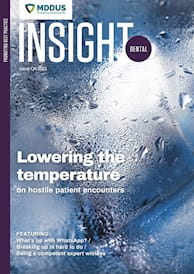Deceased patient’s records
Q Our practice has had a request for access to the dental records of a deceased patient from a relative who claims to be executor of her estate. How should we proceed?
The correct process is set out in the Access to Health Records Act (1990). The AHRA allows for a personal representative of the deceased patient to apply in writing to the record holder for access. A "personal representative" is an individual entitled to administer the estate of the deceased by virtue of a grant of probate (if a will was left) or by letter of administration if the patient died intestate (no will is left), and this term is effectively synonymous with "administrator" or "executor". The applicant should provide proof that they have the right of access as a personal representative. This could be a solicitor’s letter confirming the appointment, or a copy of the relevant part of the deceased’s will. In preparing copies of medical records, check whether the deceased asked for certain information to be withheld and ensure there are no references to third-party information, such as personal details regarding a named relative.
Signage
Q Our practice is planning to market an expanded teeth-whitening and non-surgical cosmetic treatment service. This includes new signage assuring potential patients that we are ‘GDC and HCIS registered’. Does this sound okay?
The proposed signage would appear to state that the practice is registered with the GDC. The GDC does not offer entity registration. Therefore, your signage would need to stipulate that the individual treating clinicians were registrants and provide their names and registration numbers (as required by the GDC’s advertising guidance).
Dental photography
Q I’m a GDP and do a lot of dental photography. Do I need the patient's consent if I share anonymous photographs of their teeth (only) on social media?
The GDC states in its standards guidance that if you want to use patient information, including photographs, for any reason you must obtain and record the patient’s consent for use. This is required even if the patient remains anonymous. To secure consent you must explain how the information or images will be used (e.g. posting on a dental forum or advertising) and check that the patient understands what they are agreeing to. You should also only release or use the minimum information necessary for the requested purpose and explain to the patient that they can withdraw their permission at any time.
Late patients
Q Our practice has a policy for late attendance at dental hygienist appointments. Late patients are offered the option of attending the remainder of their appointment or can pay a cancellation charge and make a new 20-minute appointment. Most opt for the former but where do we stand from a legal point of view if the hygienists only have time to provide what they might perceive as a sub-standard job?
We appreciate that you are attempting to offer late-attending patients the widest choice of solutions to their predicament – and GDC guidance advises that clinical decisions should be shared between the clinician and the patient. However, patients cannot consent to harm. Therefore, if the hygienist feels that the patient’s late attendance will compromise the ability to carry out satisfactory treatment it is advisable that a shortened appointment is not offered. Should the hygienist judge that there is sufficient time to complete a component of the planned treatment, a choice might be offered but the patient should be alerted to the fact that a future appointment may be necessary. This situation must be approached with caution, as the fact that treatment was rushed in order to accommodate a late-attending patient would be unlikely to stand as a satisfactory legal defence.
Temporary restoration
Q Can our practice dental therapist place temporary restorations in cavities or for lost fillings without the need to ask a dentist specifically for a referral?
It would be perfectly reasonable for a hygienist or therapist to place a temporary restoration in a cavity or to replace a filling, without recourse to the dentist. Placing temporary dressings is within the GDC Scope of practice for dental therapists/hygienists either “direct to patients or under prescription from a dentist”, provided they are “trained, competent and indemnified”. It would then be a matter of the patient being advised to attend for a follow-up appointment with a dentist so that the clinical situation could be assessed for permanent restoration.
Not CBCT-competent
Q I’ve been recently employed as an associate at a dental practice and have been asked if I can take CBCT (cone beam computed tomography) scans. This was not something covered in detail in my university course. Can I take on this task if instructed how? Do I need to have additional training or a certificate?
Ionising radiography is carefully controlled by legislation and anyone involved in the exposure of a patient has to be trained and competent for that role. This is made explicit in official government guidance for the use of CBCT in dentistry, which details the necessary training. What is clear from the guidance is that you cannot simply be shown how to expose a CBCT and then launch off independently. The GDC also states in its Scope of practice guidance: “You should only carry out a task or type of treatment or make decisions about a patient’s care if you are sure that you have the necessary skills and are appropriately trained, competent and indemnified. If a task, type of treatment or decision is outside your scope of practice or you do not feel that you are trained and competent to do it you must refer the patient to an appropriately trained colleague.”
This page was correct at the time of publication. Any guidance is intended as general guidance for members only. If you are a member and need specific advice relating to your own circumstances, please contact one of our advisers.
Read more from this issue of Insight Dental

Save this article
Save this article to a list of favourite articles which members can access in their account.
Save to library
